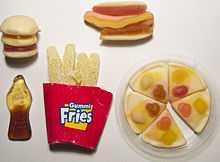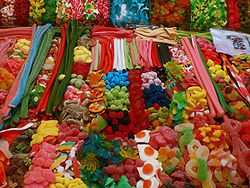Gummi candy
| Gummi candy | |
|---|---|
|
Collection of gummy candies at a market | |
| Alternative names | Gummies, jelly sweets |
| Type | Confectionery |
| Place of origin | Germany |
| Creator | Hans Riegel Sr. |
| Main ingredients | Gelatin |
| Variations | Gummi bear, gummi worms |
|
| |
Gummi candy, gummy candy, gummies, or jelly sweets are a broad category of gelatin-based, chewy candies. In the United States and Germany, gummi bears are the most popular and best known of the gummi candies. Other common shapes include bottles, worms, frogs,[1] hamburgers, sharks, toy soldiers, full-size rats, large human body parts (hearts, feet, faces), Ampelmännchen and Smurfs.
Gummi candy is sometimes combined with other forms of candy, such as marshmallow, chocolate, or sour sugar.
History
Gummies have a long history as a popular confectionery. The candy was invented in Germany by Haribo, by its founder Hans Riegel Sr.[2]
In 2008, R.M. Palmer Co. signed an agreement with Ringling Bros. and Barnum & Bailey Circus to become a licensee producing seasonal novelty gummies sold in bags, boxes, or tins.[3][4]
Types of gummies

Bears
The gummi bear originated in Germany, where it is popular under the name Gummibär (rubber bear) or Gummibärchen (little rubber bear). Hans Riegel Sr., a candy maker from Bonn, started the Haribo company in 1920.
Worms
Gummi worms are a common variation first introduced by Trolli, a brand of the German Mederer GmbH (although the American branch is owned by Kraft Foods since 1996) on July 15, 1981, the 60th anniversary of gummi bears. The average gummi worms created by Trolli are advertised to be about 5 cm long. Gummi worms vary from 10 to 25 cm and have two different colors and flavors that mix in the middle of the gummi worm. Some other brands of gummi worms have more than two colors, and are longer than the original Trolli Brite Crawlers, and may have a sour coating or other variations.
Bottles

Cola bottles are sweets in the shape of classic Coca-Cola-style bottles with a cola flavor. They are produced by numerous companies. "Fizzy Blue Bottles", made by Lutti (formerly part of the French division of the Leaf Candy Company, now controlled by a private investment group), are sweets typically found in a pick and mix selection. They are very similar to cola bottle gummies in shape, but blue and pink coloured and usually sour. "Blue Bottles", a variation from another company, have small rims around the sides, and are chewier and thicker, with a sweeter taste.
Rings
Ring-shaped gummi candy is often covered in sugar or sour powder. The most common and popular flavor is the peach ring, but other flavors include green apple, melon, blue raspberry, strawberry, and aniseed - although these are typically coated in chocolate. A commonly known producer of gummi rings is Trolli, for which the gummi rings are an important asset.[5]
Red frogs
In Australia, jelly confectionery in the shape of frogs has been very popular since the 1930s. They are coloured red or green, although they are usually referred to as "red frogs".
Road kill gummies
In February 2005, following complaints by the New Jersey Society for the Prevention of Cruelty to Animals, Kraft decided to stop production of the controversial Trolli U.S. Road Kill Gummies. The society complained that the products, shaped as partly flattened squirrels, chickens and snakes, would give children an incorrect message on the proper treatment of animals.[6]
Teeth gummies
In Australia, jelly confectionery in the shape of teeth has been very popular since the 1930s. They are coloured pink and white, with pink representing the gums and teeth being white. They have a slight minty flavour, similar to mint toothpaste.
Health considerations
Gummies landed on the "What's out in 2009" list for some Canadian schools, along with chocolate, chocolate chips and buttons, fudge, chocolate coated nuts and fruit, bubble gum, lollipops, toffee, jelly beans, marshmallows, sherbet, and Turkish delight.[7] An audit in parts of Victoria, British Columbia, was planned for 2009 to ensure the government ban on selling the confectionery in school canteens and vending machines is obeyed.[7]
Scientists have studied adding the tooth-protecting sugar substitute xylitol to gummies to fight tooth decay.[8]
Choking risks are higher with gummi candies, research shows that "hard, round foods with high elasticity or lubricity properties, or both, pose a significant level of risk." especially to children younger than three years.[9]
See also
- Fruit Gems
- Gumdrop
- Jelly baby
- Quince cheese
- Swedish fish
References
- ↑ "9 Toledo-area gifts for $25 or less". The Toledo Blade. 30 November 2008. Retrieved 19 February 2010.
- ↑ "The history of HARIBO International". HARIBO. 2010. Retrieved 19 February 2010.
- ↑ "Ringling Bros. and Barnum & Bailey licensees signed". Kids Today. 21 November 2008. Retrieved 19 February 2010.
- ↑ "Trolli Brain Surge". Convenience Store News. 10 November 2008. Retrieved 19 February 2010.
- ↑ "Trolli - trolliapfelringe225g". Trolli.de. Retrieved 2011-12-15.
- ↑ "Trolli Road Kill dies under pressure from animal activists.". Candy Business. 1 March 2005. Retrieved 19 February 2010.
- ↑ 7.0 7.1 "Schools join in healthy eating". The Stawell Times News. 25 November 2008. Retrieved 19 February 2010.
- ↑ "Gummy Bears Can Fight Cavities". OneIndia.in. ANI. 2008. Retrieved 19 February 2010.
- ↑ http://www.ijporlonline.com/article/S0165-5876%2808%2900129-8/abstract
